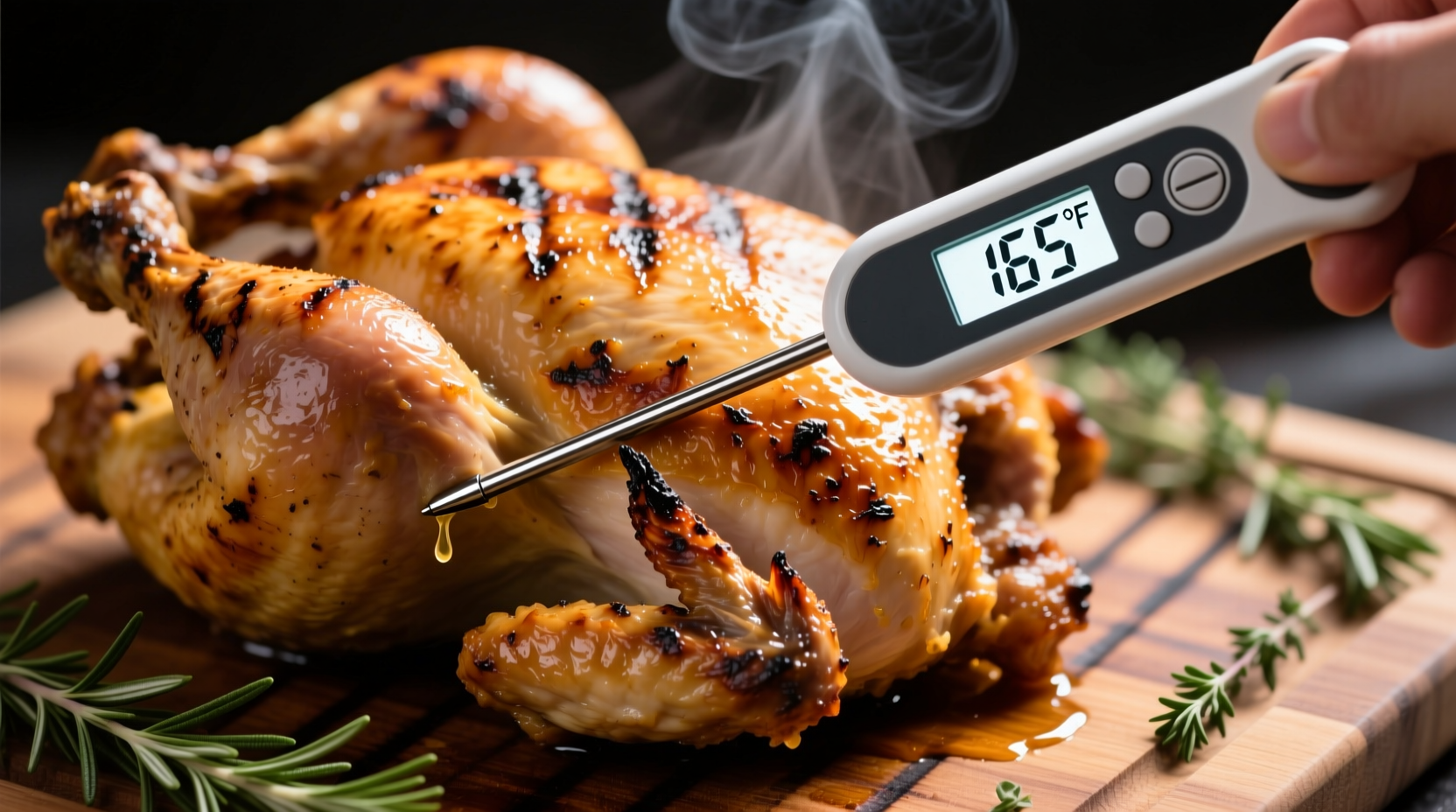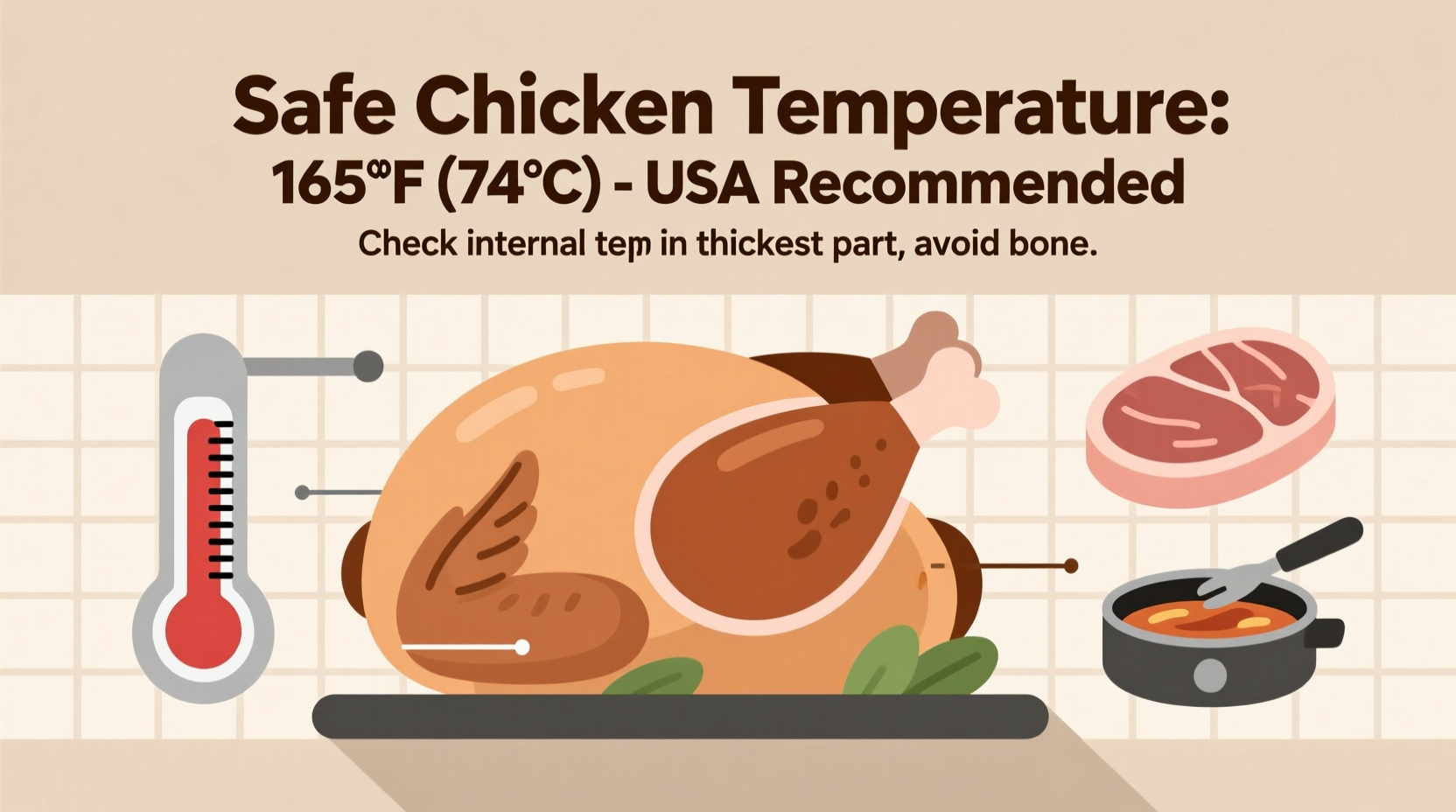The safe minimum internal temperature for cooked chicken is 165°F (73.9°C), as verified by the USDA Food Safety and Inspection Service. This temperature destroys harmful bacteria like salmonella and campylobacter that can cause foodborne illness. Always use a food thermometer to verify doneness, as color and texture alone cannot guarantee safety.
Why 165°F Is the Gold Standard for Chicken Safety
When you're preparing chicken at home, hitting the right temperature isn't just about taste—it's a critical food safety requirement. The USDA Food Safety and Inspection Service has established 165°F (73.9°C) as the minimum safe internal temperature for all poultry products. At this precise temperature, dangerous pathogens like salmonella and campylobacter are eliminated within seconds, making your meal both delicious and safe.
Many home cooks mistakenly rely on visual cues like color changes or juice clarity to determine doneness. However, the USDA explicitly states that these methods are unreliable. Chicken can appear fully cooked—with no pink hues and clear juices—while still harboring harmful bacteria. Only a properly calibrated food thermometer provides the certainty you need.
Measuring Chicken Temperature Correctly: A Step-by-Step Guide
Getting an accurate temperature reading requires proper technique. Follow these steps for reliable results:
- Select the right thermometer: Digital instant-read thermometers provide the most accurate and quickest results for home use.
- Insert in the thickest part: For whole chickens or large pieces, insert the probe into the deepest part of the meat without touching bone.
- Check multiple spots: On bone-in pieces, measure both near the bone and in the thickest muscle area.
- Wait for stabilization: Keep the thermometer in place until the reading stops changing (usually 10-15 seconds).
- Clean between measurements: Sanitize your thermometer with hot, soapy water after checking each piece.
| Chicken Cut | Recommended Placement | Minimum Safe Temp |
|---|---|---|
| Whole Chicken | Inner thigh, not touching bone | 165°F (73.9°C) |
| Breasts | Thickest part, away from bone | 165°F (73.9°C) |
| Thighs/Drumsticks | Meat near bone and thickest area | 165°F (73.9°C) |
| Ground Chicken | Center of patty or meatball | 165°F (73.9°C) |
| Stuffed Chicken | Center of stuffing and chicken | 165°F (73.9°C) |
Understanding Temperature Variations Across Cooking Methods
Different cooking techniques require slightly different approaches while maintaining the same safety standard. Whether you're grilling, roasting, or using specialized methods like sous vide, the 165°F endpoint remains essential for safety.
Traditional cooking methods (baking, grilling, pan-frying) follow the standard 165°F rule. The USDA's recommendation applies universally across these techniques because they all involve relatively high heat that quickly brings chicken to safe temperatures.
Sous vide cooking introduces an interesting nuance. While the USDA standard remains 165°F, precision cooking at lower temperatures for extended periods can also achieve safety. For example, holding chicken at 145°F for 9.2 minutes or 150°F for 2.8 minutes provides equivalent pathogen reduction. However, for home cooks without precise temperature control, sticking with the standard 165°F remains the safest approach.

Common Temperature Mistakes That Compromise Safety
Even experienced cooks sometimes make critical errors when checking chicken temperatures. Recognizing these pitfalls can prevent foodborne illness:
- Not calibrating thermometers: All thermometers drift over time. Test yours in ice water (should read 32°F/0°C) or boiling water (212°F/100°C at sea level) before critical use.
- Measuring too early: Pulling chicken from heat and immediately checking temperature gives falsely low readings as carryover cooking continues.
- Ignoring resting time: Chicken continues cooking after removal from heat. For large pieces, remove at 155-160°F to reach 165°F during the 5-10 minute rest period.
- Single-point measurement: Different parts of chicken cook at varying rates. Always check multiple locations, especially with bone-in pieces.
What Happens If Chicken Doesn't Reach 165°F?
Consuming undercooked chicken poses significant health risks. The FDA Food Code specifies that poultry must reach 165°F because this temperature instantly destroys:
- Salmonella: Causes diarrhea, fever, and abdominal cramps; responsible for over 1 million foodborne illnesses annually in the US
- Campylobacter: The most common bacterial cause of foodborne illness, leading to severe gastrointestinal symptoms
- Avian influenza viruses: Though rare in properly handled commercial poultry, these pathogens are destroyed at 165°F
The CDC reports that improperly cooked poultry accounts for approximately 21% of all foodborne illness outbreaks. Symptoms typically appear 6-48 hours after consumption and can last 4-7 days, with severe cases requiring hospitalization.
Special Considerations for Different Chicken Products
While the 165°F rule applies universally, certain chicken products require extra attention:
- Pre-cooked chicken products: Rotisserie chickens and other pre-cooked items should maintain 140°F or higher until served. When reheating, bring to 165°F.
- Chicken stuffing: If cooking stuffing inside chicken, ensure both the stuffing and surrounding meat reach 165°F.
- Ground chicken: More surface area means more potential contamination. Always verify 165°F throughout the product.
- Chicken tenders/nuggets: Commercially processed products may contain binding agents that affect texture, but safety temperature remains 165°F.
Temperature Timeline: How Food Safety Standards Evolved
Chicken cooking recommendations have evolved significantly based on scientific research:
- 1940s-1970s: Recommendations focused on visual cues and cooking times rather than specific temperatures
- 1980s: USDA established 180°F as the safe temperature for whole chickens, based on limited pathogen research
- 1990s: Research showed pathogens were destroyed at lower temperatures; recommendation lowered to 170°F for breast meat, 180°F for thighs
- 2006: USDA simplified guidelines to 165°F for all poultry products based on comprehensive pathogen studies
- 2011: FDA Food Code officially adopted 165°F as the standard for retail and food service establishments
- Present: 165°F remains the universal standard, with additional guidance for precision cooking methods
This evolution reflects increasingly sophisticated understanding of food microbiology. The current standard represents the minimum temperature that provides immediate pathogen destruction while preserving optimal texture and moisture.
Practical Tips for Perfectly Cooked, Safe Chicken Every Time
Implement these professional techniques to achieve both safety and quality:
- Thermometer placement matters: For bone-in pieces, insert the thermometer between the leg and thigh for whole chickens, or into the thickest part of the breast without touching bone.
- Account for carryover cooking: Remove chicken from heat at 155-160°F; the temperature will continue rising 5-10 degrees during resting.
- Rest properly: Let cooked chicken rest 5-10 minutes before cutting to allow juices to redistribute and final cooking to complete.
- Verify before serving: Check temperature again after resting, especially with larger cuts, to ensure it hasn't dropped below 140°F.
- Store safely: Refrigerate leftovers within 2 hours (1 hour if room temperature exceeds 90°F) at 40°F or below.
Remember that food safety guidelines exist for good reason. The USDA Food Safety and Inspection Service maintains these standards based on extensive research to protect consumers. When in doubt about chicken doneness, always check with a thermometer rather than guessing.











 浙公网安备
33010002000092号
浙公网安备
33010002000092号 浙B2-20120091-4
浙B2-20120091-4